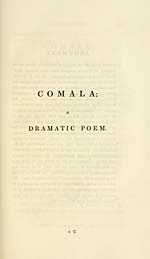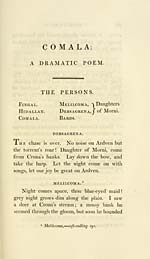Ossian Collection > Poems of Ossian > Volume 1
(278)
Download files
Complete book:
Individual page:
Thumbnail gallery: Grid view | List view

ARGUMENT.
This poem is valuable on account of the light it throws on the
antiquity of Ossian's compositions. The Caracul men-
tioned here is the same with Caracalla^ the son of Severus,
who in the year 211, commanded an expedition against the
Caledonians. The variety of the measure shews that the
poem was originally set to music, and perhaps presented
before the chiefs upon solemn occasions. Tradition has
handed down the story more complete than it is in the
poem. " Comala, the daughter of Sarno, king of Inistore
or Orkney islands, fell in love with Fingal, the son of
Comhal, at a feast, to which her father had invited him,
[Fingal, Book III.] upon his return from Lochlin, after the
death of Agandecca. Her passion was so violent, that she
followed him disguised like a youth, who wanted to be
employed in his wars. She was soon discovered by Hi-
dallan the son of Lamor, one of Fingal's heroes, whose love
she had slighted some time before. Her romantic passion
and beauty recommended her so much to the king, that
he had resolved to make her his wife, when news was
brought him of Caracul's expedition. He marched to stop
the progress of the enemy, and Comala attended him. He
left her on a hill, within sight of Caracul's army, when he
himself went to battle, having previously promised, if he
survived, to return that night." The sequel of the story
may be gathered from tlie poem itself.
This poem is valuable on account of the light it throws on the
antiquity of Ossian's compositions. The Caracul men-
tioned here is the same with Caracalla^ the son of Severus,
who in the year 211, commanded an expedition against the
Caledonians. The variety of the measure shews that the
poem was originally set to music, and perhaps presented
before the chiefs upon solemn occasions. Tradition has
handed down the story more complete than it is in the
poem. " Comala, the daughter of Sarno, king of Inistore
or Orkney islands, fell in love with Fingal, the son of
Comhal, at a feast, to which her father had invited him,
[Fingal, Book III.] upon his return from Lochlin, after the
death of Agandecca. Her passion was so violent, that she
followed him disguised like a youth, who wanted to be
employed in his wars. She was soon discovered by Hi-
dallan the son of Lamor, one of Fingal's heroes, whose love
she had slighted some time before. Her romantic passion
and beauty recommended her so much to the king, that
he had resolved to make her his wife, when news was
brought him of Caracul's expedition. He marched to stop
the progress of the enemy, and Comala attended him. He
left her on a hill, within sight of Caracul's army, when he
himself went to battle, having previously promised, if he
survived, to return that night." The sequel of the story
may be gathered from tlie poem itself.
Set display mode to: Large image | Transcription
Images and transcriptions on this page, including medium image downloads, may be used under the Creative Commons Attribution 4.0 International Licence unless otherwise stated. ![]()
| Early Gaelic Book Collections > Ossian Collection > Poems of Ossian > Volume 1 > (278) |
|---|
| Permanent URL | https://digital.nls.uk/77790065 |
|---|
| Description | Volume the first. |
|---|---|
| Shelfmark | Oss.88 |
| Additional NLS resources: | |
| Attribution and copyright: |
|
| Description | Selected books from the Ossian Collection of 327 volumes, originally assembled by J. Norman Methven of Perth. Different editions and translations of James MacPherson's epic poem 'Ossian', some with a map of the 'Kingdom of Connor'. Also secondary material relating to Ossianic poetry and the Ossian controversy. |
|---|
| Description | Selected items from five 'Special and Named Printed Collections'. Includes books in Gaelic and other Celtic languages, works about the Gaels, their languages, literature, culture and history. |
|---|

